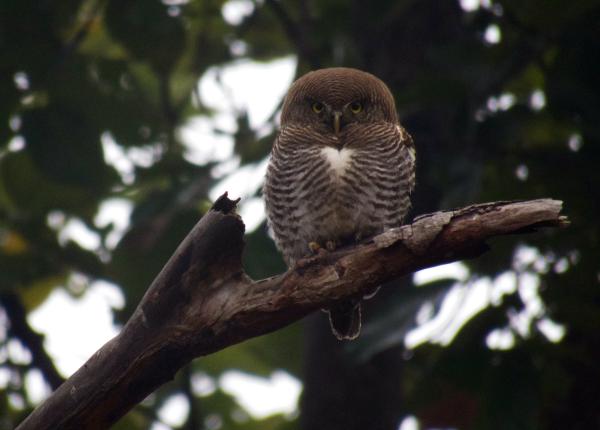Did You Know?
- There are two known subspecies of the Jungle Owlet.
- This owl's flight has been described as "swift and direct" - and has been compared to the flight style of a small hawk, rather than an owl.
- This owl's call has been described as a "loud trill"
How The Peregrine Fund is Helping
Though The Peregrine Fund does not work directly with the Jungle Owlet, our efforts in scientific research, habitat conservation, education, and community development help conserve raptors around the world. We also supply literature to researchers from our avian research library, which helps scientists around the world gather and share important information on raptor conservation.
Where They Live
The Jungle Owlet is found throughout most of the Indian Subcontinent. It can be found in the following countries: India, Sri Lanka, Nepal, Bhutan, Myanmar, and Bangladesh. It likes to spend its time in deciduous jungles, foothills, areas of scrub and bamboo, and can sometimes even be found near agricultural fields.
What They Do
The Jungle Owlet is a stunning little raptor. It has a round head and lacks ear tufts. It has bright yellow eyes, and it legs are covered in feathers nearly down to the toes. This lovely owl is a mix of brown, rufous, white, and cream. It has a lovely reddish patch on its underwing which is quite conspicuous when it flies. Its facial disk isn't as obvious as many other owl species, but it does have one of course! This owl's facial disc is finely barred with beige and brown.
At this point you might be wondering what exactly a facial disc is. A bird's facial disc is composed of many feathers that surround its head and helps direct sound to their ears. To get an idea of how it works, cup your hands behind your ears and listen – sounds will be louder and clearer. Owls can raise these feathers slightly when on the hunt, allowing them to hear the rustle of a mouse in the grass, the flapping of feathers in the night, or the slithering of a snake on a tree branch. These sounds give away the location of prey animals, making it easy for these owls to deftly swoop in to catch a meal.
Similar to the Bat Falcon of Central and South America, the Jungle Owlet is considered a crepuscular species. This means it is most active about one hour before dusk and one hour after sunrise.
Why They Need our Help
This species is classified as a species of Least Concern, which means biologists aren't too concerned about this species' population in the near future. However, it is important to note that this species is probably affected by deforestation.
What They Eat
The Jungle Owlet is an insect connoisseur. It feeds on a variety of these invertebrates including beetles, locusts, grasshoppers, and cicadas. But its diet doesn't stop there. This small owl will also feed on reptiles, such as lizards, small birds, and small mammals, such as rodents.
Nests, Eggs, and Young
There isn't a lot of information out there about the breeding habits of the Jungle Owlet. Like many other owl species, the Jungle Owlet does not build its own nest. Instead, it lays its eggs in tree cavities. The female can lay between 2-4 eggs.
Jungle Owlet and the World Center for Birds of Prey
The World Center for Birds of Prey offers fun ways to learn about birds of prey. Interactive activities, tours, interesting videos and a children's room with activities from coloring sheets to quizzes to costumes await you. At our visitor center, you can see live owls up close and learn about the wonderful and interesting adaptations they have in order to survive in their respective habitats.There is also a touch table with owl feathers and other natural objects available for exploration.
References:
BirdLife International. 2016. Glaucidium radiatum. The IUCN Red List of Threatened Species 2016: e.T22689283A93225315. https://dx.doi.org/10.2305/IUCN.UK.2016-3.RLTS.T22689283A93225315.en. Downloaded on 24 August 2021.
Holt, D. W., R. Berkley, C. Deppe, P. L. Enríquez, J. L. Petersen, J. L. Rangel Salazar, K. P. Segars, K. L. Wood, and J. S. Marks (2020). Jungle Owlet (Glaucidium radiatum), version 1.0. In Birds of the World (J. del Hoyo, A. Elliott, J. Sargatal, D. A. Christie, and E. de Juana, Editors). Cornell Lab of Ornithology, Ithaca, NY, USA. https://doi.org/10.2173/bow.junowl1.01










